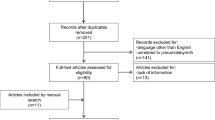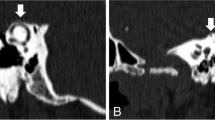Abstract
Pneumolabyrinth (PL) is the presence of air within the vestibule, semicircular canals, or cochlea. It represents an abnormal connection between the inner ear and middle ear spaces. PL most commonly occurs after blunt head trauma, followed by penetrating injuries. Temporal fractures may or may not accompany. Prognosis of hearing loss is poor, while prognosis of vestibular symptoms is good. Herein we present a 45-year-old female with unilateral pneumolabyrinth, who presented with significant dizziness and unilateral total hearing loss after a car accident.

Similar content being viewed by others
References
Mafee MF, Valvassori GE, Kumar A, Yannias DA, Marcus RE (1984) Pneumolabyrinth: a new radiologic sign for fracture of the stapes footplate. Am J Otol 5:374–375
Prisman E, Ramsden JD, Blaser S, Papsin B (2011) Traumatic perilymphatic fistula with pneumolabyrinth: diagnosis and management. Laryngoscope 121:856–859
Covelli E, Attanasio G, Cagnoni L, Viccaro M, Filipo R (2013) Pneumolabyrinth after intratympanic steroid injection in patient with prosthesis of the stapes: a case report. Am J Otolaryngol 34:759–761
Woo HJ, Song SY, Kim YD, Bai CH (2008) Pneumolabyrinth without temporal bone fracture: different outcomes for hearing recovery. Laryngoscope 118:1464–1466
Hidaka H, Miyazaki M, Kawase T, Kobayashi T (2012) Traumatic pneumolabyrinth: air location and hearing outcome. Otol Neurotol 33(2):123–131
Choi HG, Lee HJ, Lee JS, Kim DH, Hong SK, Park B, Kim SW, Kim JH, Kim HJ (2015) The rates and clinical characteristics of pneumolabyrinth in temporal bone fracture. Otol Neurotol 36:1048–1053
Tsubota M, Shojaku H, Watanabe Y (2009) Prognosis of inner ear function in pneumolabyrinth: case report and literature review. Am J Otolaryngol 30:423–426
Yanagihara N, Nishioka I (1987) Pneumolabyrinth in perilymphatic fistula: report of three cases. Am J Otol 8(4):313–318
Kobayashi T, Itoh Z, Sakurada T, Shiga N, Takasaka T (1990) Effect of perilymphatic air perfusion on cochlear potentials. Acta Otolaryngol 110(3-4):209–216
Kobayashi T, Sakurada T, Ohyama K, Takasaka T (1993) Inner ear injury caused by air intrusion to the scala vestibuli of the cochlea. Acta otolaryngol 113(6):725–730
Kösling S, Brandt S, Bloching M, Böhme S (2004) Indications of HR-CT in the early postoperative phase of stapedotomy [in German]. Rofo. 176(8):1122–1126
Bajin MD, Mocan BÖ, Saraç S, Sennaroglu L (2013) Early computed tomography findings of the inner ear after stapes surgery and its clinical correlations. Otol Neurotol 34:639–643
Zayas JO, Feliciano YZ, Hadley CR, Gomez AA, Vidal JA (2011) Temporal bone trauma and the role of multidetector CT in the emergency department. Radiographics 31(6):1741–1755
Go JL, Acharya J, Branchcomb JC, Rajamohan AG (2019) Traumatic neck and skull base injuries. Radiographics 39:1796–1807
Author information
Authors and Affiliations
Corresponding author
Ethics declarations
Ethical approval
Verbal and written consents have been obtained from the patient.
Conflict of interest
The authors declare that they have no conflict of interest
Additional information
Publisher’s note
Springer Nature remains neutral with regard to jurisdictional claims in published maps and institutional affiliations.
Rights and permissions
About this article
Cite this article
Türk, G., Kalkan, M. & Koç, A. Post-traumatic pneumolabyrinth: a rare cause of hearing loss. Emerg Radiol 27, 573–575 (2020). https://doi.org/10.1007/s10140-020-01789-y
Received:
Accepted:
Published:
Issue Date:
DOI: https://doi.org/10.1007/s10140-020-01789-y




